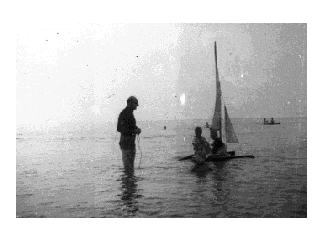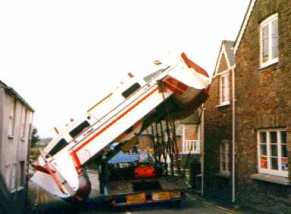Autobiography of Richard Woods
A bit about myself

(This was written in 2000 as an introduction to my original website. For more recent biographic details I suggest you read my Year Reviews and Facebook page)
The internet and web sites in general can be very impersonal, so the aim of this page is to show that catamarans designed at Woods Designs are designed by a person, not a computer!
I sailed my first catamaran in 1959, which means I could be considered a pioneer, if it wasn't for the fact that I was only 5 years old at the time, and my Dad had built my 6' long cat out of scrap timber and oil cans! But the (rather shaky) photo does show me sailing with my 2 year old brother as crew.The boat was safely tied to Dad who was holding a (very) long painter!

So, my first real sailing was in dinghies, first the Poole AB, a local children's class somewhat similar to the Optimist. But I stopped racing that once I had won the National Championships and moved on to the Mirror dinghy. A 9th place at the European Championships and second junior was my best result. I also found time to race monohulls in the Solent, mainly 1/4 tonners and 1 Tonners.
Then came a succession of International Moths (probably the most extreme singlehanders ever designed). A 10th place in the Europeans came just before I started as a yacht design student at the Southampton College of Technology.
I had been on an electronic engineering degree course at Imperial College, London University, but after 2 years I realised I prefered sailing to working in a factory, so left Imperial in 1975. The Southampton course was (maybe still is) the only full time yacht design course in the world. Many famous designers have studied there, Bill Dixon was in my year, Dave Alan Williams the year above, Ed Dubois had also been a student there. I left in 1978 with distinctions in design, structures and stability.
I believe there is a big difference in being taught (anything) full time at a college, as I was, and by a correspondence school as many others are. Face to face discussions with fellow students, never mind with lecturers must help ideas flow and understanding increase. And of course a college has assets that aren't available by mail. The use of a big test tank in my case.
I don't call myself a naval architect, even though many who took the same course as me do. Even some who have no formal qualifications at all still call themselves naval architects. I don't do so because I design yachts, whereas a naval architect is often someone who doesn't design anything, but knows a great deal about, for example, stability or ship structures.
As an aside: This technical background obviously helps me design good, safe boats, but it also led me to being asked to sit on the ISO stability committee. This international committee has been meeting for several years and comprises known experts in their fields and discusses and formulates rules for all craft. I am the only multihull designer on the committee, other members have expertise in power boats and monohulls. I also used my dinghy sailing and rowing boat design work to help with small boat stability. I have since been asked to sit on the UK's MCA small craft advisory working group. I don't believe in bureaucracy so always consider the needs of sailors and boatbuilders first. It doesn't always make me popular!
Throughout my dinghy sailing and monohull racing days I had maintained my interest in catamarans - monohull design simply didn't interest me at all. I remember as a child I was always making catamaran models and dreaming of winning races or sailing oceans - always in catamarans.
So during my summer vacations as a design student I got a job working for James Wharram on his Pahi range of designs. As a result, I got the chance to sail the Atlantic on the Wharram's own 51' Tehini. In the Caribbean I sailed as mate on a 70' charter monohull (in fact an old 12m) for the season. Swapped to a Swan 55 for Antigua Race Week and then helped sail it back to Majorca via Bermuda and Gibraltar. An interesting trip, including a major electrical fire and a broken forestay when 700 miles from land. Returning to the UK I spent a year working for Derek Kelsall who gave me the opportunity to design and build my first catamaran the 9m Cockleshell Hero. The success of this boat gave me the incentive to start designing boats for other people.

I married Lilian (an expert Dutch catamaran sailor) in 1981 and during our time together we designed many of the present range of boats. Lilian was responsible for the aesthetics and much of the actual plan drawing while I concentrated on hull shapes, rigs etc. We drew the accommodation layouts together (after all, most of the time we were married we were living on catamarans - even in the snow!)

We also built quite a number of boats, ranging in size from a Pixie and Quattro 16 to the Sagitta and our largest project, the 35' Banshee. We sailed these boats far and wide, not just in races (like the 2-handed Azores and Back Race and Yachting Monthly Triangle Race - we won both of them incidentally) but we also cruised extensively.

Probably our best known voyage was our single-handed trip (three of us in 3 different Strider Clubs) from Plymouth up through the Baltic to the Soviet Union and back during the summer of 1989.

I've always preferred day racing in small boats rather than racing offshore. That's why in the 1980's I initiated and then helped develop the Micromultihull Class, a class of cruiser racer trailable multihulls under 8m (26') in length. These have proved very popular, particularly in the UK and I have raced in numerous National and European Championships.
We won both the Europeans and Nationals in our Strider in 1987 and I came 3rd in another Strider in 1992. In 1994 we came 4th in the European Championships in our Wizard. In the same year I sailed with Graham Goff (who later sailed on Team Phillips with Pete Goss) on a Firebird when we won the National Championships.

One of my favourite boats was the Sagitta. Lilian and I (plus some other workers!) built the plugs, moulds and then a complete boat in our garden. It was the biggest project we've undertaken as in effect we built three boats to produce one sailing one. It was a really comfortable boat, fast and easy to sail. We cruised it between Holland and the Scilly Isles and it is now in the Mediterranean.

Sagitta was followed by the 28' Gypsy which was built on a very low budget almost completely singlehanded. Again, a nice boat to sail, but lacking the racing performance that I enjoy, so again it was reluctantly sold to make way for the 32' Eclipse.

Despite advancing years(!) my love of dinghy racing has not diminished. I have always favoured fairly extreme singlehanders, and raced a Blaze for two years - only selling it after I had won the National Championships.
I then decided there was a market for a home builders performance singlehander and so I built the 14' Stealth.

It seems from the above that all I do is sail - well maybe that's true. My motto is "The sea is for sailing on, and boats are for sailing". So I don't mind what sort of boat I sail, so long as it sails well. In that respect I am very different from the majority of designers who tend to only sail their own boats (if they sail at all that is).
Apart from anything else I feel that they are missing out a lot, and their designs suffer as a result. Its only by experiencing all types of boat in all conditions that you can really learn what makes the ideal boat. As examples of this wide range of sailing experiences in the last few years I have been crewing on a First Class 8 racing monohull (we ended up club champions), represented my sailing club match racing and competed in numerous regattas in my Stealth dinghy. And that's not forgetting a trip back from the Mediterranean in a Flica 37, racing in the Capetown to Rio Race etc!
So, I'm not someone who became a yacht designer because they liked designing boats. Rather it was because I liked sailing, but couldn't find any designs that offer the compromise between comfort and performance that I wanted.
================================
You've got this far and must now be wondering just why its important to know as much as possible about your chosen designer. Well, clearly for most people a large boat is a huge financial investment, often even more than their house (the materials alone for my Eclipse cost more than my apartment). But in some ways what is more important is that you will spend an even more valuable asset, that is your time on this earth, building and then sailing a boat. So its vital that you have a well proven boat and, to offset your time, one with a good resale value.
Maybe you are just looking at this site to just cover all your options, and actually plan to build another designers boat.
But before you do, I would urge you to check on their credentials. For example:
Have they been professionally trained as a yacht designer? (I have)
Have they had over 35 years experience as a full time multihull designer? (I have)
Have they been successful at designing both cruising and racing boats? (I have)
Have they designed a large range of different types and sold in sufficient numbers to prove their designs? (I have)
Do they build, sail and OWN their own designs (I do). Ask your designer what boat he owns and how much he sails it. Be wary of those who don't sail. I suspect all car designers own and drive a car!!
In fact, if your chosen designer can answer "yes" to all these questions then I'd like to know who he is, for to my knowledge no one else comes close to having the same experience as I do.









